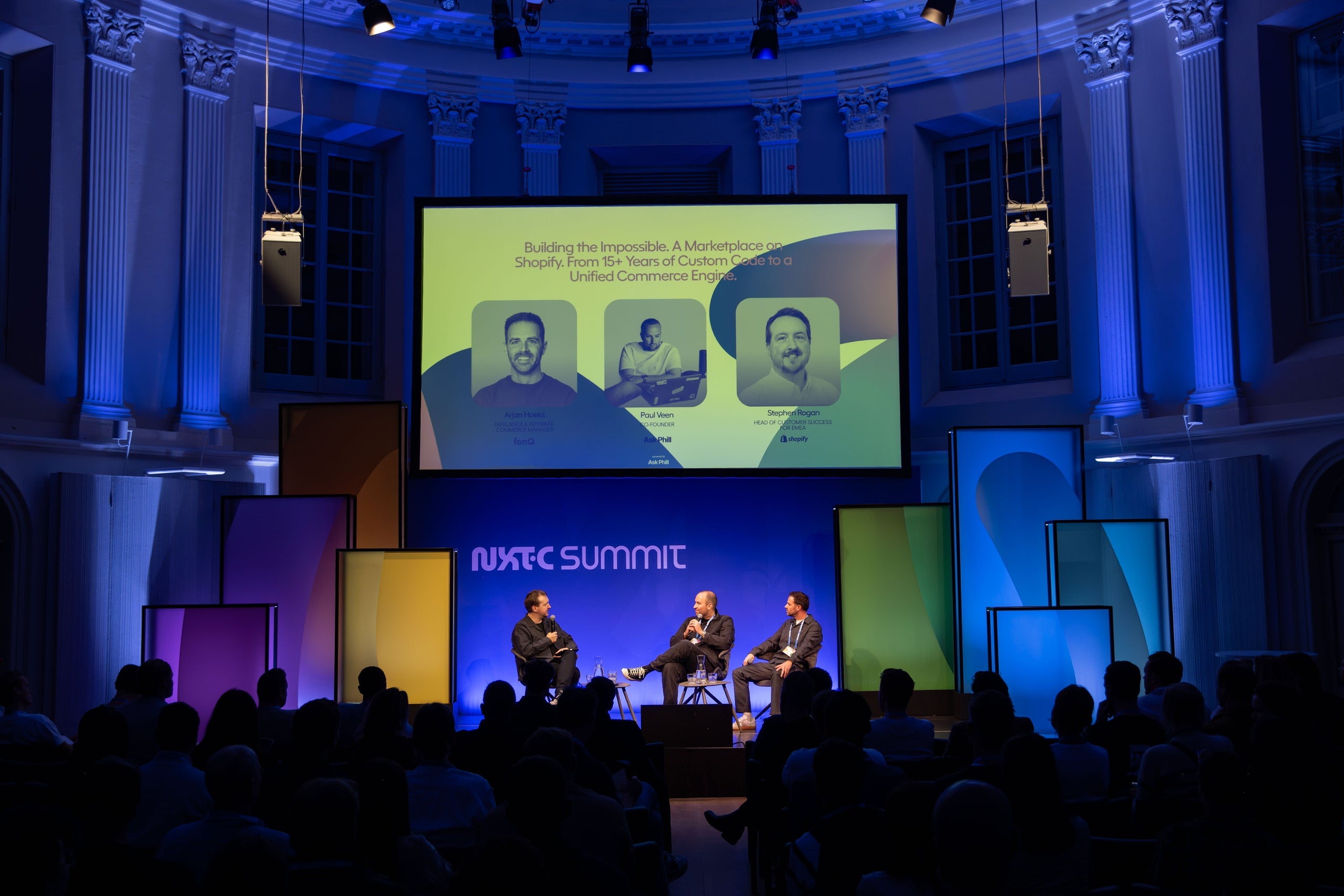
-
Shopify
+1
Klaviyo Vol 5: Solving Localised Double Opt-In at Scale
Klaviyo Vol 5: Solving Localised Double Opt-In at Scale
When to Choose Headless vs Native Shopify Plus


The question "When does headless Shopify Plus make sense?" doesn't have a one-size-fits-all answer. The right choice depends on whether headless architecture solves specific operational problems you're facing on your current platform, and whether the implementation investment delivers returns that justify the complexity.
But headless Shopify Plus isn't right for every migration. This guide explains what headless commerce actually means for Shopify Plus migrations, when it solves real problems versus adding unnecessary complexity, what realistic implementation costs and timelines look like, and how to evaluate whether your migration needs headless architecture.
It's about matching technical architecture to operational requirements for large brands migrating from Salesforce Commerce Cloud, Magento, or BigCommerce.
Headless commerce means separating your store's frontend (what customers see and interact with) from the backend (where product data, inventory, and orders are managed).
In traditional Shopify Plus implementations, the frontend and backend are connected. You use Shopify's Liquid templating language to build themes that display products, handle cart functionality, and process checkouts. The system works as a unified whole.
In headless Shopify Plus, you build a custom frontend using frameworks like React, Vue, or Angular, while Shopify Plus handles all commerce operations through its APIs. Your custom frontend queries Shopify's Storefront API to retrieve product data, manage carts, and process orders.
The term comes from decoupling the "head" (frontend/presentation layer) from the "body" (backend commerce engine). Your frontend can be anything: a website, mobile app, voice interface, or IoT device. The commerce logic stays in Shopify regardless of how customers interact with your brand.
In 2021, Shopify launched Hydrogen, a React-based framework specifically designed for building headless storefronts on Shopify Plus. Hydrogen uses modern web technologies like server-side rendering and edge computing to deliver fast, customizable experiences.
Hydrogen pairs with Oxygen, Shopify's serverless hosting platform. Together, they provide the performance benefits of headless architecture while Shopify handles infrastructure management, security, and scaling.
Before Hydrogen, brands built headless Shopify implementations using frameworks like Gatsby or Next.js with custom API integrations. Hydrogen standardized this approach with Shopify-optimized components, built-in caching, and documented integration patterns.
If you're migrating from Salesforce Commerce Cloud, Magento, or BigCommerce, you're choosing between:
Neither approach is universally better. The choice depends on specific operational requirements we'll address in this guide.
Headless e-commerce is the separation of front-end from back-end
Large brands choose headless architecture for three specific reasons. Understanding which applies to your situation determines whether headless makes sense for your migration.
Headless Shopify Plus enables performance optimizations difficult to achieve with native themes. Server-side rendering, strategic caching, and edge delivery through Oxygen deliver page loads under 1 second consistently.
This performance improvement isn't cosmetic. It directly impacts conversion rates, mobile experience, and SEO rankings through Core Web Vitals scores. Large brands report 25-40% increases in organic traffic within 6-9 months of migrating to properly optimized headless Shopify implementations, driven primarily by improved page speed affecting Google's ranking algorithm.
You can build headless Shopify Plus storefronts with custom React implementations, but Hydrogen provides Shopify-specific optimizations that improve both performance and development efficiency.
Server-Side Rendering Optimization:
Hydrogen is built on Remix, a framework specifically designed for server-side rendering. While you can implement SSR with custom React using Next.js or other frameworks, Hydrogen's integration with Shopify's Storefront API is optimized for commerce-specific rendering patterns.
Product pages, collections, and cart operations benefit from Hydrogen's built-in handling of Shopify data fetching. The framework understands e-commerce data structures and optimizes rendering accordingly. With custom React, you build these optimizations yourself, which works fine but requires more development time.
Caching Strategies Built for Commerce:
Hydrogen includes commerce-aware caching strategies that understand which data changes frequently (inventory, pricing) versus which remains static (product descriptions, collection structures). The framework automatically applies appropriate caching based on data type.
Custom React implementations require manually implementing these caching strategies. You decide what to cache, for how long, and how to invalidate cached data when products update. This level of control provides flexibility but demands expertise in cache management. Hydrogen's defaults work well for standard e-commerce operations while allowing override when needed.
Shopify API Integration:
Hydrogen provides pre-built components for common Shopify operations: cart management, product displays, variant selection, checkout initialization. These components handle Shopify's API intricacies (rate limits, pagination, error handling) automatically.
With custom React, you build these integrations from scratch using Shopify's Storefront API documentation. The API is well-documented and capable, but you're implementing connection logic, handling edge cases, and managing state yourself. For experienced React developers, this isn't problematic, but it adds development time to your implementation.
Oxygen Hosting Integration:
Hydrogen deploys seamlessly to Oxygen, Shopify's edge hosting platform included with Shopify Plus subscriptions. The framework is optimized for Oxygen's infrastructure, handling edge caching, global distribution, and deployment automatically.
Custom React implementations can deploy to Oxygen but require configuring deployment pipelines manually. Alternatively, you deploy to Vercel, Netlify, or custom infrastructure, which works well but adds separate hosting costs and configuration complexity.
Development Velocity Trade-offs:
Hydrogen accelerates development for standard e-commerce features through pre-built components and Shopify integrations. If your storefront requirements align with common e-commerce patterns, Hydrogen reduces development time compared to custom React.
However, custom React provides more flexibility for highly specialized implementations. If your requirements extend significantly beyond standard e-commerce (complex product configurators, membership systems, B2B workflows with custom logic), custom React might deliver better results by not constraining you to Hydrogen's patterns.
When Custom React Makes More Sense:
Choose custom React over Hydrogen when:
Choose Hydrogen when:
Performance Reality:
Both Hydrogen and well-built custom React implementations achieve excellent performance. The framework choice affects development efficiency more than ultimate performance capability. Poorly optimized Hydrogen performs no better than poorly optimized custom React. Skilled developers deliver fast storefronts with either approach.
If your current platform's performance directly limits revenue, or your traffic volumes demand infrastructure that scales without performance degradation, headless architecture (whether Hydrogen or custom React) solves this problem. If your native Shopify Plus implementation performs adequately, you're paying for optimization capability you don't need.
Large companies with sophisticated content operations need capabilities beyond Shopify's native content management. This includes:
Headless architecture paired with a dedicated CMS like Sanity or Contentful provides enterprise-grade content management designed for complex operations. Your content teams work in systems built for editorial workflows, while Shopify handles commerce operations.
For straightforward product catalogs where descriptions, specifications, and imagery fit comfortably in Shopify's native fields, adding a separate CMS creates unnecessary complexity. But when your content strategy extends to technical documentation, editorial storytelling, localized content across markets, or brand-specific messaging managed by different teams, a dedicated CMS becomes essential infrastructure.
The test is simple: if managing your content in Shopify's admin creates operational bottlenecks or requires extensive workarounds, an external CMS solves real problems. If your team manages content comfortably in Shopify now, you don't need this capability.
If you have an internal development team experienced with React, Vue, or modern JavaScript frameworks, migrating to Shopify Plus means choosing between retraining them on Liquid or building headless with their existing skillset.
Liquid is a proprietary templating language specific to Shopify. It's well-documented and capable, but learning it represents a learning curve for teams experienced with React or other frameworks. For agencies building multiple Shopify stores, investing in Liquid expertise makes sense. For brands with internal teams, the calculation differs.
A React development team can build headless Shopify Plus storefronts using Hydrogen without learning Liquid. They work with familiar tools, established development patterns, and skills transferable to other projects. This isn't about Liquid being inadequate. It's about leveraging existing team capabilities rather than requiring skill acquisition in a platform-specific language.
If you're hiring an agency for your Shopify Plus migration, this consideration doesn't apply. Shopify agencies already have Liquid expertise, and native implementations deliver faster time-to-value. But if you have internal developers comfortable with React who will maintain your storefront long-term, headless architecture lets them work with familiar frameworks.
These reasons appear frequently but don't justify headless complexity alone:
Multi-brand operations can work well with either native or headless implementations. Shopify Plus supports multiple storefronts natively. Headless provides operational advantages for specific multi-brand scenarios (shared component libraries, centralized content management with brand-specific permissions), but multi-brand alone doesn't require headless.
Mobile apps or additional touchpoints might suggest headless, but evaluate whether you actually need custom frontend development for these channels. Shopify's existing mobile capabilities, PWA functionality, and third-party solutions handle most requirements without custom headless development.
"Future-proofing" isn't a reason. Choose architecture that solves current operational problems. You can migrate from native to headless later when specific requirements emerge. Paying for future flexibility you might never need wastes budget better spent on current optimization.
The decision comes down to three questions: Does your performance directly limit revenue? Do you need enterprise content management with complex workflows and permissions? Does your internal team work primarily in React or modern JavaScript frameworks? If you answer yes to one or more, headless architecture might make sense. If all three answers are no, native Shopify Plus likely delivers better ROI.
Before discussing implementation, let's address when headless Shopify Plus adds complexity without corresponding value. Not every migration needs custom frontend architecture.
Headless Shopify Plus implementations start at €100k minimum for development, with complex multi-brand projects reaching €500k+. Ongoing maintenance requires dedicated React development resources.
Headless implementations require ongoing development capability. If you don't have in-house Headless developers, you'll depend on agency support for all frontend changes. This dependency is expensive since Headless implementations require more ongoing technical team.
If you operate one brand with content that fits comfortably in Shopify's native fields and workflows, native Shopify Plus provides everything you need. Unless your team has strong React expertise and prefers working in that framework, or performance issues actively limit your revenue, headless adds complexity without solving operational problems.
Native Shopify Plus implementations complete in 8-20 weeks. Headless implementations take 16-24 weeks minimum. If your migration timeline is aggressive because of platform end-of-life or contractual deadlines, native Shopify Plus delivers faster launch dates.
You can always migrate to headless later when operational complexity justifies it. Starting with native reduces initial risk.
Review the three driving factors for headless:
If you answer no to all three, native Shopify Plus almost certainly delivers better ROI for your migration. The investment in headless complexity won't solve problems you're actually experiencing.
Let's address practical questions: what does headless Shopify Plus actually cost, and how long does implementation take?
Implementation costs vary significantly based on complexity of the front-end, back-end integrations and custom feature requirements.
Standard Headless Implementation (€100k-300k):
Complex (Multi-)Brand (€350k+):
Beyond initial development, budget for:
Native Shopify Plus themes start from €60k for custom development because you're working within established theme structures. Headless requires building frontend architecture from scratch, implementing API integrations, setting up build processes, and creating component libraries.
The higher cost buys specific capabilities: advanced performance optimization, enterprise content management, or alignment with your internal team's React expertise. If you're not solving one of these three problems, the additional investment doesn't deliver corresponding value.
Understanding the technical components helps evaluate whether your team can support headless architecture.
Shopify Hydrogen (Recommended for most implementations):
Next.js (Custom React alternative):
Other Options:
Choosing Between Hydrogen and Next.js:
Choose Hydrogen when:
Choose Next.js when:
Your team needs expertise in:
If these skills aren't in-house, factor ongoing agency support into your budget.
Brands can deliver stunning, memorable e-commerce experiences without breaking the monolithic structure.
Here's what headless Shopify Plus migration actually involves for brands moving from Salesforce Commerce Cloud, Magento, or BigCommerce.
Before committing to headless, answer the three driving questions:
If you don't answer yes to at least one question, native Shopify Plus likely delivers better ROI. If you answer yes to one or more, proceed with headless architecture planning.
If headless makes sense, design your architecture:
Framework Selection:
CMS Planning (if needed):
Component Architecture:
Configure your Shopify Plus backend:
Build your headless storefront:
Core Pages:
CMS Integration:
Performance Optimization:
Thorough testing prevents launch issues:
From Ask Phill's migrations, these issues appear consistently:
Content Migration Complexity:
Extracting content from legacy platforms and restructuring for your new CMS takes longer than expected. Start content work early.
Custom Feature Rebuilding:
Features that were built into your old platform need rebuilding for headless. Budget adequate time for custom development.
Performance Optimization:
Achieving sub-second page loads requires disciplined optimization. Poorly implemented headless performs no better than poorly implemented native themes.
Team Training:
Marketing and operations teams need training on new workflows. The Shopify admin differs from legacy platforms, and CMS workflows require adjustment.
Headless Shopify Plus enables excellent performance, but only with proper implementation. Here's what to expect.
Well-optimized headless implementations should achieve:
These metrics directly impact SEO rankings, mobile conversion, and customer experience.
Headless architecture doesn't automatically mean fast sites. It provides the tools for performance optimization when implemented properly. Both Hydrogen and custom React implementations achieve excellent performance with proper development. The framework choice affects development efficiency more than ultimate performance capability.
It's increasingly important to invest in an outstanding digital brand experience.
As a Shopify Platinum Partner with 200+ migrations we've developed specific methodology for evaluating when headless architecture makes sense.
Headless Shopify Plus solves specific problems for large brands when one or more of the three driving factors apply:
Performance-Driven Migrations:
Brands migrating from platforms with performance limitations benefit from headless architecture when speed directly impacts their revenue. We see this most often with high-traffic operations where native theme optimization reaches practical limits.
Enterprise Content Management Requirements:
Large operations with complex content workflows (multiple approval stages, granular permissions, multi-brand content management) benefit from dedicated CMS integration. We typically implement Sanity for these scenarios because the Shopify Connect app simplifies product data synchronization.
Internal Team Alignment:
Brands with established React development teams migrating to Shopify Plus use headless architecture to leverage existing capabilities rather than retraining on Liquid. This is particularly common with brands that have built custom e-commerce platforms and want to maintain their team's technical approach while gaining Shopify's commerce infrastructure.
Not every €400k migration needs headless complexity. We recommend native Shopify Plus when:
Native implementations complete faster, cost less, and enable marketing team content autonomy without developer dependencies. For operations that don't answer yes to the three driving questions, native delivers better ROI.
We position headless decisions within broader platform migration strategy. The question isn't "should we use headless" in isolation. It's whether headless architecture solves one of the three specific operational problems: performance that limits revenue, enterprise content management requirements, or internal team framework alignment.
Our headless implementations for brands with 100+ SKUs run 16-24 weeks on average, compared to 8-12 weeks for native Shopify Plus implementations. This longer timeline buys specific capabilities that solve the three identified problems. If you're not solving one of those problems, the extended timeline doesn't deliver corresponding value.
The decision between headless and native Shopify Plus comes down to three specific questions about performance, content management, and team capabilities.
Book a 30-minute technical assessment with Ask Phill. We'll work through the three core questions together:
We'll review your current platform limitations, operational complexity, team capabilities, budget and timeline constraints.
It depends on whether you answer yes to one of three questions: Does performance directly limit your revenue? Do you need enterprise content management with complex workflows? Does your internal team work primarily in React? If yes to one or more, headless delivers returns that justify the investment. If no to all three, native Shopify Plus typically delivers better ROI.
Hydrogen is Shopify's official React-based framework for building headless storefronts on Shopify Plus. It includes Shopify-optimized patterns, server-side rendering, commerce-aware caching, pre-built components for common operations, and seamless integration with Oxygen hosting. Hydrogen accelerates development for standard e-commerce compared to custom React implementations.
Choose Hydrogen when building standard e-commerce functionality, you want Shopify-optimized patterns and faster development velocity, and Oxygen hosting fits your needs. Choose Next.js when your team has deep Next.js expertise, requirements extend significantly beyond standard e-commerce, or you need specific Next.js features. Both achieve excellent performance when properly implemented.
Potentially, if implemented properly and if performance currently limits your SEO. Server-side rendering delivers complete HTML to search engines, and performance optimization can improve Core Web Vitals scores that impact rankings. However, headless doesn't automatically mean better SEO. Proper implementation of meta tags, structured data, and technical SEO fundamentals matters more than architecture choice.
Yes. You can start with native Shopify Plus and migrate to headless when one of the three driving factors becomes relevant. Your product data, customer information, and apps stay in Shopify during the transition. You're rebuilding the frontend while the backend remains unchanged. This phased approach reduces initial risk.
Whether you've been inspired and want to get started on your headless project, or if you have more questions about whether headless would be right for you, get in touch with us today! Our team are always available for a consultation to help you find the solution that's right for your brand and your business.
Do you want to
stay updated?
Yes

Klaviyo Vol 5: Solving Localised Double Opt-In at Scale
Klaviyo Vol 5: Solving Localised Double Opt-In at Scale

The gap is widening
Shopify Winter '26 Edition: 10 Reasons Not Being on Shopify Is Now a Competitive Disadvantage

The early-access strategy that increased conversions to 33%
Klaviyo Vol 4: Travelteq’s WhatsApp Advantage
Stay ahead
Subscribe to our newsletter for a roundup of the latest in ecommerce, straight to your inbox.